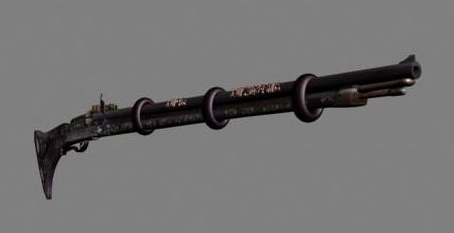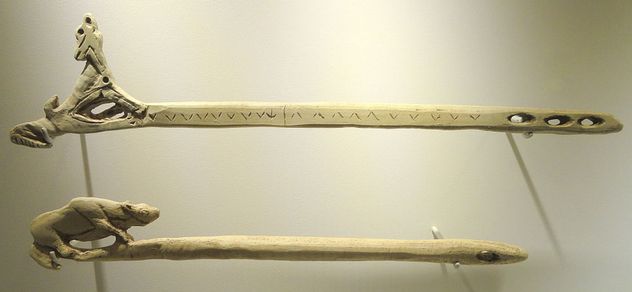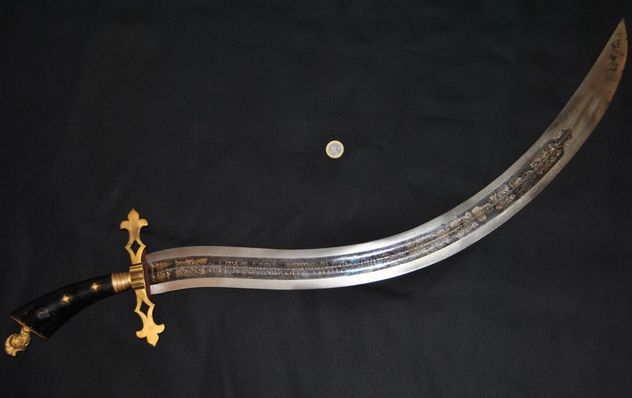5.火枪
Developed in ancient China, the fire lance was a spear-like weapon that fired a projectile with gunpowder. The earliest form was a simple bamboo tube packed with sand that was strapped to a spear. Such a weapon would have been able to blind an enemy and give the wielder the advantage in close quarters combat. As technology evolved, though, fire lances started to incorporate shrapnel and poison darts. But explosions strong enough to launch these projectiles required stronger housings, and fire lances began to be made first of a strong type of paper and then finally metal.
火枪发明于古代中国,它类似于长矛又可以发射火药枪弹。它最早的形式是:把装满沙子的竹筒绑在一个长矛上,这样,就可以弄瞎敌人的眼睛,在近距离搏斗中取得优势。随着科技的发展,火枪逐渐包含了弹片和毒镖,但是要想得到足够强大的爆炸力,火枪就必须的具备一个坚硬的外壳,初始时,火枪的外壳是由一种坚硬的纸制作的,后来变成金属制作了。

Accounts also describe a weapon called a “fire-tube” being used as a flamethrower to shower enemies with flames that were 3.5 meters (12 ft) tall. Further developments led to poisonous chemicals being mixed with the explosive mixture, which would cause the unfortunate victim’s burns to go septic. Less of an explosion and more of a steady stream of flame, weapons like these would belch “poisonous fire” for an estimated five minutes before burning out.
文献中还描述了一种名叫“火管”(fire-tube)的武器,它被用作火焰喷射器,可以给3.5米(12英尺)高的敌人带来一场“火浴”。后来它发展成为把有毒的化学物与爆炸物相混合的武器,这时,它爆炸后释放的腐蚀物能够造成无辜者的伤亡。这样的武器其爆炸规模更小但是火焰源源不断,它会释放大约五分钟的有毒气体。直到爆炸物完全燃尽。
4.梭镖投射器

A Stone Age dart weapon, the atlatl was the precursor to the bow and arrow. While spears could only be thrown at limited speeds and distances, atlatl could launch darts at over 160 kilometers per hour (100 mph). It was a deceptively simple weapon, nothing more than a handheld stick with a protrusion or notch at one end where a dart could be set. Yet despite their simplicity, atlatl were so effective that it’s even been theorized that they contributed to the extinction of the woolly mammoth they were used to hunt.
梭镖投射器是石器时代的投掷武器,是弓和箭的前身。长矛只能以有限的速度抛出较短的距离,而梭镖投射器能以每小时160千米(100英里每小时)的速度向前抛出。这是一个看似简单的武器,就是一个在末端具有突起或缺口(可以设置飞镖)的手持棍子,尽管其设计非常简单,但却非常有效,以至于有理论认为正因为人们用它来捕杀猛犸象,最终导致了猛犸象的灭绝。
The weapon’s speed came from its flexibility. Both the atlatl and the dart were made of flexible wood. The two parts bent simultaneously when the atlatl was fired, which allowed the energy stored in each to launch the dart at very high velocities. Archaeological evidence tells us that the use of the atlatl was also widespread, with examples found in every inhabited continent except Africa. Though they were eventually replaced with the easier-to-use bow and arrow, the atlatl stood the test of time, being used by the Aztecs even as late as the 1500s.
武器的速度取决于它的灵活性,atlatl 和飞镖都是用柔韧的木头制成。当射击时,atlatl 和飞镖同时弯曲。这样一来,汇聚的能量将使飞镖获得极高的速度。考古发现,atlatl 的使用相当广泛,除了非洲之外,每一个有人居住的大陆都发现了它曾广泛被使用的证据。尽管其最终被更为方便的弓箭所代替,不过atlatl 的使用持续了很长时间,甚至在16世纪时还被阿兹特克人作为武器使用。
3.镰刀剑

Although sometimes called a sickle-sword, the ancient Egyptian khopesh was more of a cross between a sword and a battle ax. During earlier Egyptian times, the mace represented ruling power, but the khopesh‘s deadliness on the battlefield eventually made it the preferred status symbol of Egypt’s elite. Even Ramses II was depicted wielding one.
尽管有时被称作镰刀剑,khopesh作为古埃及的武器之一,不仅仅是战斧和剑之间的过度物。在古埃及早期,权杖代表着执政权,但是khopesh在战场上的致命性最终使得其被看作古埃及上层精英的象征。甚至拉美西斯二世都被描绘使用过khopesh。
A Bronze Age weapon, the khopesh was usually cast out of a single piece of bronze and could be quite heavy. It’s believed to have been an Egyptian adaptation of a large, two-handed weapon similar to a war ax, imported from Canaan and Mesopotamia. The blade had a pronounced curve, like a sickle, though only the outside edge was sharpened. Much like the battle ax, the khopesh could be used as a hacking weapon, though its shape also made it efficient at slashing. The inner part of the curve was equally functional and could trap an arm or yank away an opponent’s shield. Some had small snares for that very purpose.
作为青铜时代的武器,khopesh由铜块铸造而成,但却具有一定重量。它被认为是与战斧相似的双手武器,从迦南和美索不达米亚进口。刀刃有明显的弧度,就像一把镰刀,只有外部边缘被磨得锋利。与战斧相似,khopesh可以当作劈砍武器来使用。它的外形使其在劈砍上也十分高效。khopesh弧度的内侧部分也具有实际功能,能够用来制止敌人的武器,还能猛拉敌人的护罩。
2.Shotel

Unlike the khopesh, the shotel was a true sickle-sword once used in ancient Ethiopia. Its shape made it extremely difficult to block with another sword or even a shield—shotel would just curve around it to puncture the defender. Despite that and its vicious appearance, it was almost universally considered useless.
与khopesh所不同,shotel曾经确实被古埃塞尔比亚人当做镰刀剑使用。它的外形使其很难与其他刀剑或者护罩进行格挡。不考虑它的外观,shotel被普遍认为不实用。
The hilt was too small for a large, scythe-shaped blade, which made it an unwieldy weapon to hold or aim properly. Fighting with a shotel proved quite difficult. Because of the shape of the blade, even drawing it from its scabbard was somewhat awkward. Scabbards stretched a foot longer than the swords themselves and were worn pointing behind the owner, which meant drawing it with the blade facing the correct way required a large bend of the wrist. European accounts of the weapon were extremely negative, and even the Ethiopians themselves considered shotels little more than ornamental. They had a saying about the shotels that essentially deemed the weapons useful for nothing more than impressing women. We suppose some weapons were just meant for a different kind of battle.
与巨大的镰刀形刀刃相比,它的手柄太小了些,这使得它不但显得笨重,且难以瞄准目标。使用shotel作战被证明非常之难。因为它的刀刃的形状,就连想要将其从剑鞘里拔出都会很棘手。欧洲对于该武器的记载和评价都偏低,就连埃塞尔比亚正教会也说它只适合装饰所用。也许该武器是为了别样的战争而制造出来的吧。
1.剑鞭

Urumi were flexible sword whips. The blade itself was made of extremely bendable metal that, when not in use, could be wrapped around the waist like a belt. Blade lengths differed, but urumi could reach lengths of 3–5 meters (12–16 ft).
Urumi 是易弯曲的剑鞭,刃片是由弯曲度很高的金属打造而成。不用时,可像腰带一样缠在腰上。刃片长短不一,Urumi能够达到3-5米长。
rumi were whipped in circles, creating a defensive zone difficult for an opponent to penetrate. With both sides of the blade sharpened, they were extremely dangerous even for the wielder and required years of training. Even simple things like stopping the weapon and changing directions were considered special skills difficult to master. Due to the unique fighting style, urumi could not be used in battle formations and were better suited for man-to-man combat and assassinations. Yet despite the stringent requirements for wielding one properly, they were an unstoppable force once mastered. Parrying proved almost useless against an urumi, because even if an opponent tried to stop it with a shield, the urumi would just bend around it to strike.
Urumi 可以弯成一个小圆圈,形成一个防御区,敌人很难渗入进来。Urumi 的每一面都很尖锐,即使针对训练多年的使用者来说也相当危险。哪怕是最简单的停住或者改变方向都需要具有高超技巧才能做到。由于独特的战斗风格,Urumi 不适合用于战斗队形,只适用于两个人之间的对决。
















